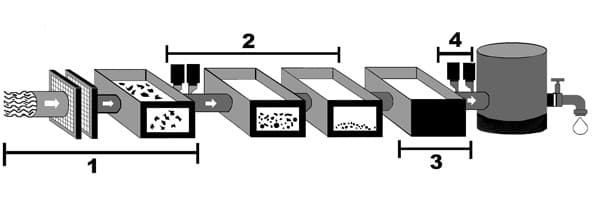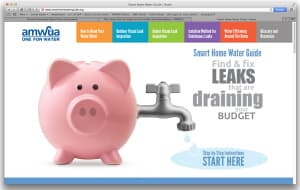AMWUA Blog
BY: Kathleen FerrisDrinking Water: You Have Better Things To Worry About

Ever wonder about the quality of water that comes out of your faucet?
If you live in the City of Phoenix, most of your water comes from the Colorado, Salt and Verde rivers. Water is delivered to treatment plants via aqueducts, reservoirs and local canals that crisscross the city. Only about 2 percent is groundwater delivered by the city’s wells.
The water is screened, settled, filtered and disinfected before it reaches your home.

1. Screen large particles 2. Add a chemical that makes tiny particle cling and sink. 3. Filter to clean remaining particulates. 4. Disinfect and add small amount of fluoride.
Phoenix water professionals conduct millions of tests and measurements on that water every year, so you can stop wondering. Here are a few samples of the testing done by the city:
- Turbidity: Turbidity readings measure the water’s clarity. Turbidity is an indicator that the treatment process is removing tiny particles, including microorganisms. Turbidity readings from individual filters are stored every five minutes. That’s about 5 million turbidity measurements a year.
- pH levels: The term pH is used to indicate the alkalinity or acidity of a substance. Maintaining the appropriate pH levels in the water controls corrosion of lead and copper in household plumbing. The city measures the pH of the water leaving the treatment plants and within the distribution system more than 500,000 times a year. That is an average of 1,370 each day.
- Coliform bacteria: Coliforms are bacteria that are naturally present in the environment. They may indicate that other, potentially harmful, bacteria may be present. Phoenix collects more than 360 routine samples each month, over 4,320 per year, to monitor conditions throughout the water’s distribution system.
- Disinfection byproducts: Water managers must keep enough disinfectants, such as chlorine, in the water to ensure it is safe, but excessive levels of disinfectants can create additional contaminates. The city tests for disinfection byproduct levels at water treatment plants and in the distribution system 17,000 times a year. That is an average of 46 times each day.
In 2012, Phoenix installed $200 million worth of new technology that cleans the water beyond the drinking water standards set by the U.S. Environmental Protection Agency (EPA).
That was a smart move because drinking water standards change. Technical advances are making it possible to detect smaller and smaller amounts of existing contaminants and new contaminants that enter the environment. Public and private water agencies are always monitoring and collecting data on unregulated contaminants, such as certain compounds in pharmaceuticals and fire fighting foams, to help EPA make informed decisions. Water agencies also must stay one step ahead of changing standards so they have the time and money to meet the standards.
So how would you know if something unsafe has made its way into your drinking water? In a small area, a Phoenix employee would visit your home to alert you. On a larger scale, the city would notify the media and post information on its website. The good news: Phoenix’s water system has built-in redundancy. That means if water in one line is questionable, the city can often shut down that line and reroute different water to your neighborhood.
Here’s a surprise: As long as the water is safe, EPA isn’t as tough about how it tastes or smells or if it is hard or soft. These are considered “aesthetics” that cannot make people sick. The EPA has a set of recommended secondary standards or guidelines for drinking water aesthetics, important to many water departments eager to make their customers happy. Phoenix works to make its tap water tasty and odor free. Algae that grow in the Valley’s canals during the summer are the source of an occasional musty odor. Phoenix works with Salt River Project, which operates the canals, to control the algae. The city's new equipment also helps to reduce aesthetic issues.
There is something you can do to help make sure your drinking water stays safe.
- Use water wisely: Remember the money and time that has gone into cleaning the water that comes into your home. Know the right amount of water needed to keep your landscape thriving. Use AMWUA’s mobile-friendly Smart Home Water Guide to detect water leaks inside and outside your home.
- Maintain home water filters: Neglected filters or softening systems you have installed at home can grow bacteria and contaminate your water.
- Protect our water: Limit the amount of pesticides and fertilizer you use in your yard or on your business’s landscaping. Take household chemicals to hazardous collection sites to keep them out of the landfill. Never dump any hazardous substances, such as pain or oil, in a storm drain. Don’t flush used medications down the toilet.

If you want to know more, the City of Phoenix’s website has detailed information and answers to frequently asked questions about the drinking water it delivers. We all have enough to worry about. The quality of your tap water shouldn’t be one of them.
For 46 years, Arizona Municipal Water Users Association has worked to protect our member cities’ ability to provide assured, safe and sustainable water supplies to their communities. For more water information visit www.amwua.org .
